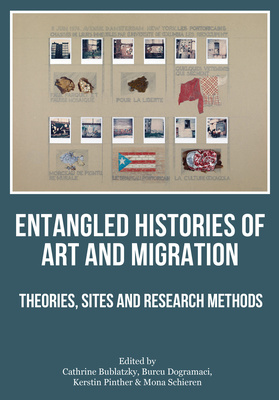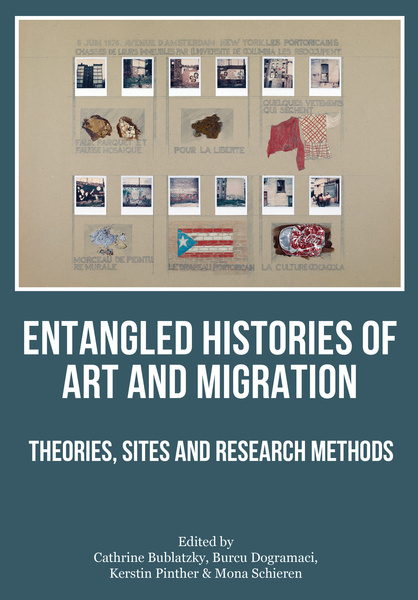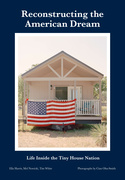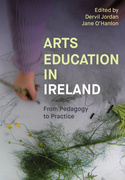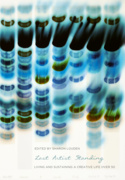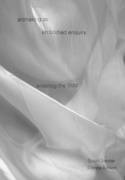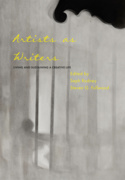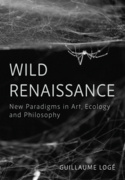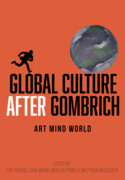Entangled Histories of Art and Migration (Book)
Theories, Sites and Research Methods
Dedicated to the stories of migrants, refugees, asylum seekers, and exiles, this collection explores the entanglements of art and aesthetic practices with migration, flight, enforced dislocation and border/border crossings in global contexts – a significant phenomenon of social transformation in the 20th and 21st centuries. 131 b/w illus.
Edition
Dedicated to the stories of migrants, refugees, asylum seekers, and exiles, this collection asks how these stories are interwoven with art, art practices, activism, reception, and (re-)presentation. It explores the complex entanglements of art and aesthetic practices with migration, flight, and other forms of enforced dislocation and border/border crossings in global contexts - the latter significant phenomena of social transformation in the twentieth and twenty-first centuries.
These entanglements take centre stage when migration shapes forms and aesthetics (and vice versa), when actors employ image politics and visualisation strategies in and about migration at different times and places, or when materialities, sites, and spaces gain importance for decision-making processes.
Giving space to these stories of art and migration and its power of pluriverse knowledge production, the book takes an art and cultural studies perspective and questions the significance of spatial changes for artistic practice in migration and elaborates on new or different theory formation. Bringing together its case studies and theoretical approaches, the argumentation unfolds over the five sections of the book Visibilities | Invisibilities, Sites | Spaces, Materiality | Materialisation, Racism | Resistance and Practices | Performativity.
Cathrine Bublatzky, Ph.D., is a visual and media anthropologist. She is a senior lecturer and researcher at the Department of Social and Cultural Anthropology at Tübingen University in Germany. In her recent research and publications she focuses on migration, visual cultures, and the aesthetics and politics of belonging.
Burcu Dogramaci is professor of twentieth-century and contemporary art history at the Ludwig-Maximilians-Universität Munich (LMU). In 2016 she was been awarded an ERC Consolidator Grant and leads the research project 'Relocating Modernism: Global Metropolises, Modern Art and Exile' (METROMOD).
Kerstin Pinther is a professor of African art history and curator for modern and contemporary art in a global context at the Staatliche Museen Berlin, Germany.
Mona Schieren is professor of transcultural art histories at the Hochschule fur Kunste, Bremen, Germany. She is a member of the DFG research network Entangled Histories of Art and Migration: Forms, Visibilities, Agents and the SNSF research project Materialized memories (in) the landscape at the Zurich University of the Arts.
List of figures
Introduction
Cathrine Bublatzky, Burcu Dogramaci, Kerstin Pinther
and Mona Schieren
SECTION 1: VISIBILITIES | INVISIBILITIES
Cathrine Bublatzky and Burcu Dogramaci
1. Artistically Juxtaposed (Hi)stories: Hiwa K’s View
from Above as a Multidirectional Memory Practice
Kea Wienand
2. “I Like It but That’s Not What We Need”: Critical Ethnographic
Accounts of Art Workshops in Refugee Reception Centres
Alessandro Mazzola
3. Making Precarious Migrant Workers Visible and Audible
Through Art and Ethnography
Burcu Dogramaci and Ger Duijzings
4. Between Lights and Shadows: Border Crossing and the Art
of ‘Seeing’ and Being Seen
Sholeh Shahrokhi
SECTION 2: SITES | SPACES
Kerstin Meincke and Kerstin Pinther
5. Towards a Minor Textile Architecture: Kathryn Clark,
Loren Schwerd, and Igshaan Adams
Jessica Hemmings
ENTANGLED HISTORIES OF ART AND MIGRATION
6. Spatial Practices, Craftsmanship, and Empowerment.
On the Collaborative Project Faţadă/Façade on Roma
Building Culture in Dortmund
Kerstin Meincke
7. Evolution of a Hybrid Typology: Catholic Churches
Built in Huế, Vietnam in the Early Twentieth Century –
Nationalism and Decolonisation
Phi Nguyen
8. Atmospheres of Designed Diversity? The Spatial Politics of
Superkilen in Copenhagen
Mareike Schwarz
SECTION 3: MATERIALITY | MATERIALISATION
Buket Altinoba and Alma-Elisa Kittner
9. Silk Road Works
Azra Aksamija
10. Singular Travels: Microhistory as a Museology
of Migration
Fabrice Langrognet
11. A Painting Goes into Exile. Picasso’s Guernica in the
United States
Martin Schieder
12. Displaced Migrant Mobility: On Reappropriating Spaces
Through Embodied Materiality
Lilian Haberer
13. Norman Lewis’ Black Paintings in the 1960s:
Diasporic Image Concepts of Materiality and
Historicity
Angela Stercken
14. Halil Altındere’s Wonderland: Sacralisation and Subversion
in Sulukule
Gabriele Genge
15. On Materiality, Migration, and the Arts
Alma-Elisa Kittner
SECTION 4: RACISM | RESISTANCE
Elke Gaugele and Birgit Mersmann
16. The Difficulty of Remembering Racism Jena, Chemnitz,
Zwickau, and the NSU Complex
Maria Alexopoulou
17. Migratory Birds
Cana Bilir-Meier
18. Curatorial Strategies and Anti-racism in the Museum:
‘Exhibiting’ Racism, Resistance, and Empowerment
Josephine Apraku, Ismahan Wayah and Susanne Wernsing
19. Decolonial Insurgency for Art-Systemic Change:
Dissenting Art Museums in New York
Birgit Mersmann
20. Entangled Histories and ‘Influence’: Loïs Mailou Jones’
View on the Black Arts Movement in Her 1976 Dakar Lecture
Annabel Ruckdeschel
SECTION 5: PRACTICES | PERFORMATIVITY
Burcu Dogramaci, Franziska Koch and Mona Schieren
21. Reparative Workshop and Body Practices in the Field of
Art, Diaspora, and Migration 1969 and 2020
Elke Gaugele and Mona Schieren
22. On the Performative Theory of a Migrant Body:
Theorising Bodily Speech Act – Thinking Together with Judith Butler
Yana Meerzon
23. China–Africa: Performing the Image of Migration and
Migration of Image
Mi You
24. On the (Im)possibilities of Migrating Images
Anahita Razmi and Cathrine Bublatzky
25. Beyond Apprenticeship: El Loko and Joseph Beuys
Anna K. Brus
26. Living Migration on Fluxus Island? Artistic World-Making as Both
Collaborative and Transcultural Endeavour
Franziska Koch
Biographies of the Authors
The essays gathered in Entangled Histories of Art and Migration: Theories, Sites and Research Methods epitomize the recent ‘migratory turn’ in art-related studies, which has introduced new critical and interdisciplinary methodologies and a much-needed reappraisal of the ways in which migrants, exiles, refugees and asylum seekers are represented in art, architecture, activism, exhibitions, and more. By exploring topical subjects such as the practices of (in)visibilization of migrant and refugee lifeworlds and the production of space and images in diaspora, along with racism and anti-racism resistance in museums and curating, the volume’s in-depth case studies make a valuable, pluriversal contribution to contemporary debates on how migration and forced displacement figure within the field of global art.
Anne Ring Petersen, professor, department of Arts and Cultural Studies, University of Copenhagen
Entangled Histories of Art and Migration: Theories, Sites and Research Methods is a dynamic intervention into the now burgeoning field of art and migration studies. The authors and editors of this rich anthology raise urgent questions about both what we know of the histories of cultural movement and exchange, and how such knowledge is produced in and through the visual, material and spatial registers of the arts. This is a timely engagement with an issue of critical importance and a thought-provoking work of scholarship.
Marsha Meskimmon, emerita professor of transnational art and feminism, Loughborough University
How do art and aesthetic practices reckon with the processes of migration, dislocation, and border crossings world-wide? Bringing together practices and perspectives from art history, ethnography, activism, and performance studies, this timely and important volume offers a far-reaching response to this question. By investigating the intricate entanglements between art and migration, these essays inspire (and are inspired by) highly creative approaches to some of the most urgent societal questions of our time.
Saloni Mathur, professor and chair of art history, UCLA
This book productively deploys a concept whose meaning is usually taken in a negative or dubious sense: entanglements, which are considered messy and problematic; a meaning at issue we consider migration, displacement, and what I call ‘refugeedom’. But when the disciplines touched by millennia-old and now so current entanglements involved with those social practices and situations engage other, very different ones, such as the intellectual and artistic forms of interdisciplinary work, a new field emerges, which addresses, maps, and improves this impossible and necessary task of bringing the victims of violence and social inequality from their invisibility to ‘visibilisation’, which helps not only their situation, but also the limitations of disciplinary academic work, by means of entanglements rather than dogmatic separations.
Mieke Bal, cultural analyst, video artist and curator

